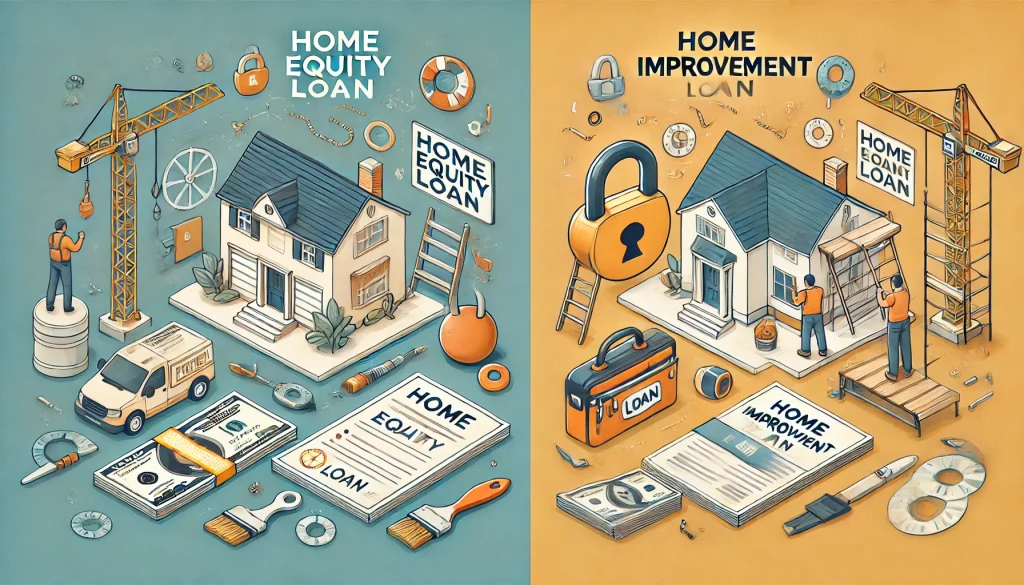Home Equity Loan vs. Home Improvement Loan: What’s the Difference?
Home Equity Loan vs. Home Improvement Loan: This guide will help you understand their differences and determine the right choice for your home projects.

Homeowners often find themselves needing extra funds for various reasons, from remodeling kitchens to consolidating debts. Two popular options are home equity loans and home improvement loans. However, the differences between them can be confusing. This article aims to clarify these differences and help you determine which loan is best for your needs.
What is a Home Equity Loan?
Definition and Basics
A home equity loan is a type of loan in which the borrower uses the equity of their home as collateral. Equity is the difference between the home’s current market value and the amount still owed on the mortgage. Essentially, it’s a second mortgage that allows homeowners to borrow against their equity.
Pros and Cons
Pros:
- Fixed Interest Rates: Most home equity loans come with fixed interest rates, making monthly payments predictable.
- Large Loan Amounts: Because the loan is secured by your home, you can often borrow larger amounts than with unsecured loans.
- Tax Deductible Interest: In some cases, the interest paid on home equity loans is tax-deductible.
Cons:
- Risk of Foreclosure: Since your home is collateral, failing to make payments can result in foreclosure.
- Closing Costs and Fees: These loans often come with closing costs and fees, similar to your original mortgage.
- Longer Processing Time: Approval and processing can take several weeks, as it involves an appraisal of your home’s value.
What is a Home Improvement Loan?
Definition and Basics
A home improvement loan, on the other hand, is an unsecured personal loan that is used for funding home renovations. Unlike home equity loans, these loans don’t require your home as collateral. They are based primarily on your creditworthiness and income.
Pros and Cons
Pros:
- No Collateral Required: Your home isn’t at risk if you default on the loan.
- Faster Approval: These loans can often be approved more quickly than home equity loans, sometimes within a few days.
- Flexible Usage: Funds can be used for various home improvement projects without restrictions.
Cons:
- Higher Interest Rates: Since they are unsecured, these loans typically have higher interest rates compared to home equity loans.
- Smaller Loan Amounts: You may not be able to borrow as much as you could with a home equity loan.
- Shorter Repayment Terms: The repayment period is usually shorter, which can result in higher monthly payments.
Key Differences Between Home Equity Loans and Home Improvement Loans
Collateral Requirements
Home equity loans require you to use your home as collateral, putting it at risk if you fail to repay. Home improvement loans are unsecured, so no collateral is needed, and your home remains safe.
Interest Rates and Terms
Home equity loans generally have lower interest rates because they are secured by your home. They also offer longer repayment terms, typically 5 to 30 years. Home improvement loans, being unsecured, come with higher interest rates and shorter terms, usually 2 to 7 years.
Usage Restrictions
Home equity loan funds can be used for any purpose, including debt consolidation, education expenses, or large purchases. Home improvement loans are specifically intended for home renovation and improvement projects.
Which Loan is Right for You?
Factors to Consider
- Current Home Equity: If you have substantial equity built up in your home, a home equity loan might offer better terms.
- Credit Score: Home improvement loans require a good credit score. If your credit is less than stellar, you might have better luck with a home equity loan.
- Financial Goals: Consider what you need the loan for and how much you need to borrow. Home equity loans are better for large expenses, while home improvement loans are suitable for smaller projects.
Case Scenarios
- Home Equity Loan: Ideal if you plan to finance a major renovation, consolidate debt, or cover large expenses.
- Home Improvement Loan: Best for smaller home upgrades, such as kitchen remodeling or bathroom updates, without risking your home.
How to Apply for Each Loan
Application Process for Home Equity Loans
- Evaluate Your Equity: Determine how much equity you have in your home.
- Shop Around for Lenders: Compare interest rates, terms, and fees from various lenders.
- Submit an Application: Provide necessary documentation, including proof of income, home value, and existing mortgage details.
- Undergo a Home Appraisal: The lender will likely require an appraisal to determine your home’s current market value.
- Close the Loan: Once approved, you’ll sign the loan documents and receive your funds.
Application Process for Home Improvement Loans
- Check Your Credit Score: Ensure your credit score is in good shape.
- Research Lenders: Look for lenders offering competitive rates and favorable terms.
- Submit an Application: You’ll need to provide income verification, employment history, and details of the home improvement project.
- Get Approved and Receive Funds: Approval is typically quicker than for home equity loans, and you can receive funds within days.
Alternatives to Consider
Personal Loans
Personal loans are another option for funding home improvements. They are unsecured and can be used for various purposes, including home renovations. They often have higher interest rates than home equity loans but don’t require collateral.
HELOCs (Home Equity Lines of Credit)
A HELOC is a revolving line of credit that allows you to borrow against your home’s equity as needed. It offers more flexibility than a home equity loan, as you can withdraw funds up to a certain limit and only pay interest on what you borrow.




